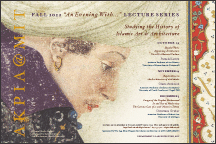Lectures, Conferences & Events» Past Lectures & Events
Studying the History of Islamic Art & Architecture
Glaire D. Anderson
Explorations in the Architecture of al-Andalus
Biography
Glaire D. Anderson (Ph.D., HTC/AKPIA at MIT, 2005) is a historian of Islamic art and architecture with a focus on Iberia and North Africa in the early caliphal period. Her publications consider Cordoban aristocratic estates and court culture; women, eunuchs and court patronage in al-Andalus; and the roles of architecture and objects in cultural interchange between medieval Islamic societies and their neighbors. In 2009 Anderson held a fellowship from the American Council of Learned Societies, and her work has been recognized by the College Art Association, the Samuel H. Kress Foundation, the Society of Architectural Historians, and the Barakat Foundation. She is Associate Professor of Islamic Art History at the University of North Carolina at Chapel Hill and serves on the Executive Board of the Historians of Islamic Art Association as Treasurer.
Christiane Gruber
Images of the Prophet Muhammad In and Out of Modernity: The Curious Case of a 2008 Mural in Tehran
Abstract
In 2008, a five-story mural was painted onto the wall of an apartment building in the northern section of Tehran. The mural represents the Prophet Muhammad’s ascension into the heavens, as well as an inhabitant of Paradise offering a flower to a man in the lower right corner. While the composition is based on a 15th-century “Book of Ascension” manuscript, it nevertheless has been altered in two significant ways: first, a man painted in a hyper-realistic mode has been inserted into the composition and, second, the facial features of the Prophet have been removed. Tracing how the original painting has been pictorially augmented and edited for the public sphere, this talk offers some new ideas on how images are received and updated in modern Islamic artistic practices. It will do so by paying special attention to the mural’s symbolic position within Tehran’s martyrial mural program, Iran’s Shi‘i-Islamic political agenda, and oppositional responses to the Jyllands-Posten cartoon controversy of 2005-2006.
Pamela Karimi
Beyond Walls: Appraising Architecture Vis-à-Vis Material Culture
Abstract
Since the publication of Arnold Hauser’s The Social History of Art in 1951, the scholarly melding of divergent focuses into single conversation implies, it would seem, an underlying indivisibility. Taking up diverse topics—ranging from the complex interactions between designers and patrons to the objects of material culture that mediate between design and the consumer— architectural historians have exerted beyond iconography, stylistic classifications, and manifestations of the genius of designers. Many scholars who have explored the built environment of the Persianate world have likewise embraced non-architectonic data: An esteemed study of the distribution of paper scrolls influencing innovative architectural revetments at the time of the Timurids, alongside an astute exploration of the ways Safavid feasting ceremonies (and associated material constituents) delineated the shape of Isfahan’s palaces, are two examples. At the same time sociologists, extending their territories beyond canonical sources of art and architectural libraries, call attention to agency on the part of the most ordinary of citizens, functioning to transform their built environments via commonplace mediators. In addition, the rapid growth of material culture studies suggests potential acts of agency as performed by architectural elements themselves. For example, one anthropologist’s recent work, in allowing for a novel understanding of modern Shiraz, suggests that freestanding ancient-looking columns play a part in defining and defending particular collective identities. Thus, while because of the historical burden of the architectural canon, material culture has not always merged easily into studies of Iranian architecture, instances are numerous in which buildings have been appraised vis-à-vis material culture. In this presentation, I foreground the place of material culture in the historiography of Iranian architecture, whilst introducing several case studies from my own research on domesticity in Modern Iran. Divided into three thematic sections (namely, images, objects, and bodies) my presentation will demonstrate how the study of material culture—with its processes of production, circulation, appropriation, mediation, and domestication—might allow for a more nuanced evaluation of Iranian architectural practices.
Biography
Pamela Karimi is Assistant Professor of Art History at the University of Massachusetts Dartmouth. She received her PhD from HTC/AKPIA at MIT in 2009. Karimi’s publications include Domesticity and Consumer Culture in Iran: Interior Revolutions of the Modern Era (Routledge, February 2013);Images of the Child and Childhood in Modern Muslim Contexts (August 2012), a special issue of Comparative Studies of South Asia, Africa, and the Middle East co-edited with Christiane Gruber; and catalogue essays on the work of artist and actor Anthony Quinn, among others. She is the recipient of the 2012 Creative Economy Fund (with Thomas Stubblefield) for Urban Renewal in Massachusetts Gateway Cities—a lecture series that brings together prominent scholars, chronicling the cultural and economic history of gateways cities in Massachusetts. In January 2013, she will co-curate, Exploring Urban Identities in De-industrialized Cities, at the New Bedford Art Museum. Karimi is the editor of H-AMCA, the online network of the Association of Modern and Contemporary Art of the Arab World, Iran, and Turkey. She serves on the editorial team of The International Journal of Islamic Architecture.
